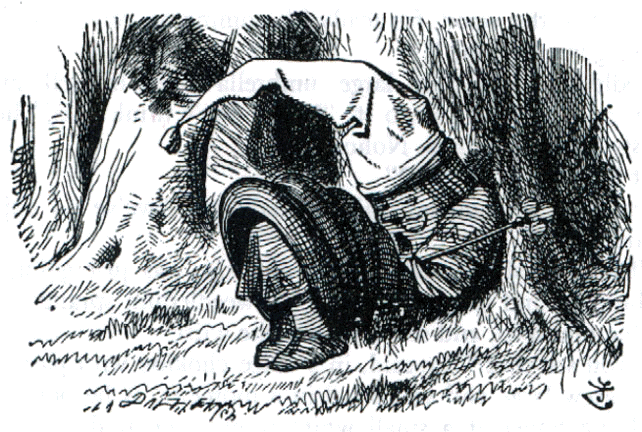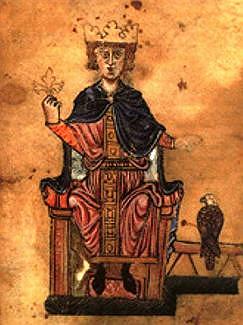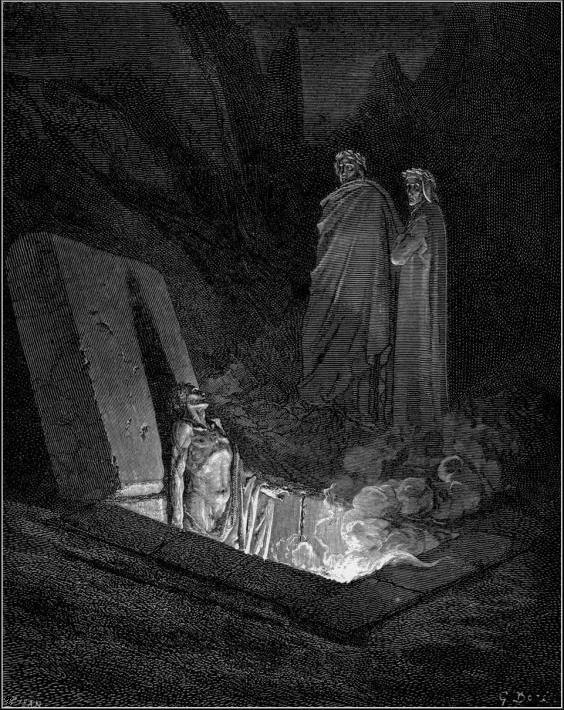PROMENADE THE PUZZLE
The Poetic Vision of Peter Sinfield

PREFACE

 |
|
"The cathedral of Palermo is the last resting-place of a man described by his contemporaries as 'the terror of the earth', 'the wonder-working transformer', the Emperor Frederick II. His lion throned sarcophagus of blood-red porphyry is a monument so classical, so proud and so unapproachable that it involuntarily calls to mind Napoloeon's tomb in Paris." - The Medieval World by Friedrich Heer (p. 267) "In Frederick II, one of the most fascinating personalities of Western civilization enters upon the historical stage. He has been called the first modern man, a precursor of the great figures of the Renaissance, a humanist and a skeptic. To his friends he appeared as the Messiah, the herald of universal peace, the God-Emperor of a new age, while his enemies saw in him a ruthless tyrant and the incarnation of the anti-Christ, whose coming spelled ruin and the end of the world. The modern historian recognizes in Frederick the antagonistic elements of a historic constellation in which two epochs meet and clash – the ecclesiastical civilization of the middle ages and the secularized modern world." - Kurt F. Reinhardt Germany 2000 Years (p. 93) |
.jpg) |
|
|
"He called himself "lord of the world"; Norman and German in ancestry but essentially a Sicilian, Frederick always felt a stranger in Germany. He spent most of his time in Italy and Sicily, where his legal reforms set up an efficient administration. This system he tried, with some success, to transfer to Germany." "Frederick was also a gifted artist and scientist. A poet himself, he was surrounded by Provençal troubadours and German minnesingers. He patronized science and philosophy and interested himself in medicine, mathematics, astronomy, and astrology. His De Arte Venandi cum Avibus, on hawking as well as the anatomy and life of birds, was the first modern ornithology." - The Columbia Encyclopedia |
|
""Major cultural centre during the first half of the XIII century, the court of Emperor Frederick II of Swabia (1194-1250) represented the real place where men and cultures, East and West, languages and literary traditions met and exchanged. The Poetic School was born within Frederick's court, that is, that poetic movement which marked the beginning of lyric poetry in Italian. The Emperor was among the authors of the first love poems in Vulgar." - The Sicilian Poetic School by Giuseppina Brunetti "Frederick spoke six languages fluently, among them Greek and Arabic…he had read the Koran and…He got on well with Muslim rulers, whom he considered his only cultural equals. - The Situation In Europe by Erik Hildinger "The result of getting an Arabic view of Christianity and a Christian view of Islam, was to make him believe that all religions were impostures, a view held perhaps by many a stifled observer in the Age of Faith. But he talked about his views; his blasphemies and heresies are on record." - H. G. Wells The Outline of History Vol. II "It was rumored that Frederick had written a book titled De Tribus Impostoribus ("About the Three Impostors"). The imposters, so the story went, he considered to be Moses, Jesus and Mohammed, the founders of the religions of the Western world. The rumor was false, but it seems to have captured the essence of his views." - The Situation In Europe by Erik Hildinger "He was a remarkable man, in advance of his times in many ways. A free thinker, he was willing to oppose the church in almost anything. He pioneered in the establishment of a complete secular government." - The Problem Of The Hammer And The Anvil by Lynn H. Nelson |
|
"He eliminated all aspects of feudal organization and directed the writing and promulgation of the Constitutions of
Melfi. This was a remarkable document, one of the earliest written constitutions and unusually liberal for the day. The Constitutions established
uniform system of laws to be observed throughout the realm. They established a standard form local government, declared that taxes would be
fair and fairly administered, and ensured that Two Sicilies would welcome trade and commerce. Perhaps most remarkable, The Constitutions
provided for representative assemblies decades before the birth of the Parliament of England. Frederick established and endowed the University of Naples, the first clearly secular university in the West. Moreover, he took care that its faculty included Christians, Muslims and Jews, and that all of these languages would be taught, together with the laws and literature of these cultures. Equally remarkable considering the times was Frederick's edict ordering religious toleration for Christians, Muslims and Jews throughout his realm." - Frederick II by Lynn Harry Nelson |
|
"In the same early thirteenth century in which Pope Innocent III gave the model for Hitler's Nuremberg laws against the Jews, there was created by Christian, Islamic, and Jewish forces the near-miracle of a tolerant humanism on the basis of current traditions at the court of Emperor Frederick II in Sicily. It took one to two centuries for similar ideas to come again to the surface, changing the Christian judgment of non-Christian religions in a radical way."
- Christianity and the Encounter of the World Religions by Paul Tillich "...in his Liber augustalis, in which we may note an idea antagonistic to the Collection of Canons and Decretals, he seeks to put forward a civil and political code based on Law, Nature and Reason. Gregory IX reproached Frederick's collection of laws, saying that these did not 'co-operate in salvation but call down evils upon many'. Frederick's struggle against the supremacy of the popes was that of a disorderly genius, who passed down to posterity as a heretic, a renegade, an Antichrist." - Dom. Luigi Sturzo Church and State "Frederick II is a very convenient example of the sort of doubter and rebel the 13th century could produce.. Through him Arabic numerals and algebra were introduced to Christian students.. .. called the "first of the moderns".. All sorts of men must have been impressed by the futility of the excommunications and interdicts that were leveled at Frederick. The revolt of the princes was essentially an irreligious revolt against the world-rule of the Church. The emperor Frederick II, with his epistles to his fellow-princes was its forerunner. The revolt of the people against the church, on the other hand, was as essentially religious." - The Latter Rain Page, Frederick II |
|
"No sooner had Frederick I (Barbarossa) perished on the third crusade in 1190, than there began to appear in Germany prophecies which foretold of a future Frederick, who as Emperor of the Last Days would complete the unfinished work; an eschatological savior who by liberating the Holy Sepulchre would prepare the way for the Second Coming and the Millennium. When thirty years later, the imperial crown was bestowed on Frederick, who was Barbarossa's grandson, these prophecies were confidently applied to him. There was much in Frederick's life and personality to foster the growth of a messianic myth. He was a most brilliant figure, whose versatility and intelligence, licentiousness and cruelty combined to fascinate his contemporaries. Moreover he did in fact go on a crusade in 1229 and was even able to recapture Jerusalem and crown himself king of that city. Above all, he was repeatedly embroiled in conflicts of extraordinary bitterness with the Papacy. Christendom was treated to the spectacle of the Emperor, several times excommunicated as a heretic, perjurer and blasphemer, threatening to strip the Church of that wealth which, he proclaimed, was the source of its corruption." - The Pursuit of the Millenium by Norman Cohn (p. 111) "What Frederick II wanted to be, it seems agreed, was the Roman emperor of old, but a "Catholic" Roman emperor--claiming that the empire was created divinely, and that he was divinely commissioned to bring about the reign of justice and peace, and also to spread the gospel everywhere. The Church, as an institution wholly self-controlled and the pope as its single supreme ruler, could scarcely find any place in this fantasy." - The Church in Crisis: A History of the General Councils: 325-1870 |
|
"It was now evident that the pope was not merely fighting another Henry IV, or Barbarossa, but an anti-ecclesiastical theory of world organisation, aggressive and fully armed. In July of 1245, two hundred bishops and abbots attended the first General Council of Lyons. It is unique in that its main purpose was a trial. The emperor was making it his life's aim to restore the ancient subordination of religion to the State. The pope was determined to destroy him." - The Imperial Menace to The Freedom Of Religion: The Emperor Frederick II
"This conflict of the imperial house of the Hohenstaufen was more imposing than the conflict waged by Henry IV. with Gregory and his successors because of the higher plane on which it was fought and the greater ability of the secular antagonists engaged. Lasting more than one hundred years, it forms one of the most august spectacles of the Middle Ages, and furnishes some of the most dramatic scenes in which kings have ever figured. The historian Gregorovius has felt justified in saying that "this Titanic war of the Middle Ages filled and connected the centuries and formed the greatest spectacle of all ages." - History of the Christian Church; Vol 5 Ch 6 by Phillip Schaff "After the reign of Emperor Frederick II, the monarch who was more often oriental than occidental, Mohammedan than Christian, and who not only failed to realize all of Pope Innocent's hopes for him but proved to be one of the most terrible foes the Church has ever had, things were never again the same." - Pope Innocent III "The final resting-place of Frederick II, according to Dante, is in a fiery coffin, in circle six with the heretics, in book ten of the Inferno (Inf. X 120)." - Dante and Frederick II: The Poetry of History Roger Dragonetti (Trans. Judith P. Shoaf) |
 Dante asks Farinata to tell him who is in there with him, and Farinata replies "Here I lie with more than a thousand. Here within is the second Frederick, and the Cardinal, and of the rest I do not speak" (Inf. X 118-119). |
"Yet Dante had the most profound respect and admiration for the Hohenstaufen. All his life Frederick II was the model of the Ruler, and Judge, the Scholar and Poet, the perfect Prince, the "illustrious Hero" who - 'so long as his good fortune lasted' - sought after the humane, the humanum, and who as a crowned monarch gathered round him the noblest and most brilliant spirits of the earth." (p. 260) - Frederick II by Ernst Kantorowicz "To Salimbene, as to Dante, Frederick was a man of heroic proportions in his very sins. "Of faith in God he had none; he was crafty, wily, avaricious, lustful, malicious, wrathful; and yet a gallant man at times, when he would show his kindness or courtesy; full of solace, jocund, delightful, fertile in devices. He knew to read, write, and sing, to make songs and music. He was a comely man, and well formed, but of middle stature. I have seen him, and once I loved him, for on my behalf he wrote to Bro. Elias, Minister-General of the Friars Minor, to send me back to my father. Moreover, he knew to speak with many and varied tongues, and, to be brief, if he had been a good catholic, and loved God and His Church, and his own soul, he would have had few equals among the emperors of the world." - Salimbene/From G. G. Coulton, St. Francis to Dante, (London: David Nutt, 1906), pp. 242-43 |
|
|
top
|
|
Sign
the Dreambook
![]() Read
the Dreambook
Read
the Dreambook

|

|

|

|

|

|

|

|

|

|

|

|

|

|

|

|
 |
 |
 |
 |
 |
|
| Works |
Lyrics
& Poems |
Gallery |
Guestbook
Archive |
Links | Discography |
E-mail:
Peter Sinfield Jon Green |
Page One |

 Arachnophilia
Arachnophilia